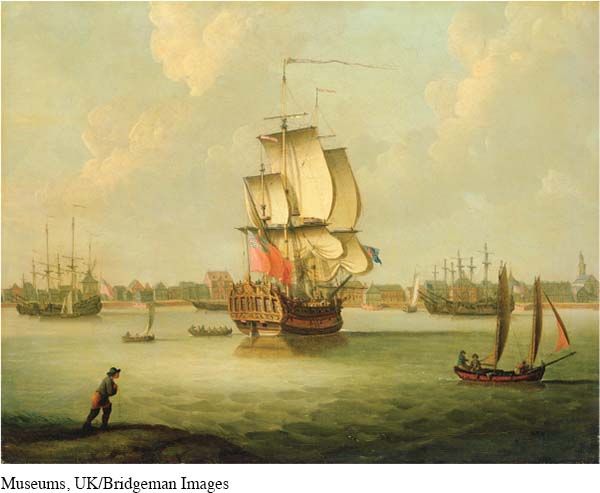Seaport Cities and Consumer Cultures
The same trade in human cargo that brought misery to millions of Africans provided traders, investors, and plantation owners with huge profits that helped turn America’s seaport cities into centers of culture and consumption. Charleston was one of the main ports receiving African slaves in the early 1700s, and Eliza Lucas was impressed with its prosperous character. Arriving in 1738, she noted that “the Metropolis is a neat pretty place. The inhabitants [are] polite and live in a very gentile [genteel] manner.” North American seaports, with their elegant homes, fine shops, and lively social seasons, did capture the most dynamic aspects of colonial life. Although cities like New York, Boston, Philadelphia, Baltimore, and Charleston contained less than 10 percent of the colonial population, they served as focal points of economic, political, social, and cultural activity.

Affluent urban families created a consumer revolution in North America. Changing patterns of consumption challenged traditional definitions of status. Less tied to birth and family pedigree, status in the colonies became more closely linked to financial success and a genteel lifestyle. Successful men of humble origins and even those of Dutch, Scottish, French, and Jewish heritage might join the British-dominated colonial gentry.
Of those who made this leap in the early eighteenth century, Benjamin Franklin was the most notable. Franklin was apprenticed to his brother, a printer, an occupation that matched his interest in books, reading, and politics. At age sixteen, Benjamin published (anonymously) his first essays in his brother’s paper, the New England Courant. Two years later, a family dispute led Benjamin to try his luck in New York and then Philadelphia. His fortunes were fragile, but unlike William Moraley Jr., he combined hard work with a quick wit, good luck, and political connections, which together led to success. In 1729 Franklin purchased the Pennsylvania Gazette and became the colony’s official printer.
While Franklin worried about the concentration of wealth in too few hands, most colonial elites in the early eighteenth century happily displayed their profits. Leading merchants in Boston, Salem, New York, and Philadelphia emulated British styles and built fine homes that had separate rooms for sleeping, eating, and entertaining guests. Mercantile elites also redesigned the urban landscape, donating money for brick churches and stately town halls. They constructed new roads, wharves, and warehouses to facilitate trade, and they invested in bowling greens and public gardens.
The spread of international commerce created a lively cultural life and great affluence in colonial cities. The colonial elite replicated British fashions, including elaborate tea rituals. In Boston, the wives of merchants served fine teas imported from East Asia in cups and saucers from China while decorated bowls held sugar from the West Indies. However, the emergence of a colonial aristocracy also revealed growing inequality. Wealthy urban merchants and professionals lived alongside a middling group of artisans and shopkeepers and a growing class of unskilled laborers, widows, orphans, the elderly, the disabled, and the unemployed. In seaport cities, enslaved laborers might live in their owners’ homes or be relegated to separate and impoverished communities. In New York City, which boasted the second largest slave market in the mainland colonies in the 1710s, blacks were regularly buried outside the city limits. The frequent wars of the late seventeenth and early eighteenth centuries contributed to these economic and social divisions by boosting the profits of merchants, shipbuilders, and artisans. They temporarily improved the wages of seamen as well. But in their aftermath, rising prices, falling wages, and a lack of jobs led to the concentration of wealth in fewer hands.
REVIEW & RELATE
What place did North American colonists occupy in the eighteenth-century global trade network?
How and with what success did the British government maintain control over the colonial economy and ensure that it served Britain’s economic and political interests?
Exploring American HistoriesPrinted Page 86
Exploring American Histories Value EditionPrinted Page 66
Chapter Timeline